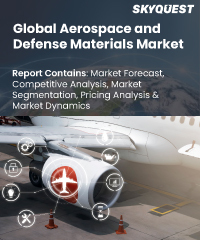
Report ID: SQMIG20A2167
SkyQuest Technology's Aerospace and defense materials market size, share and forecast Report is based on the analysis of market data and Industry trends impacting the global Aerospace and Defense Materials Market and the revenue of top companies operating in it. Market Size Data and Statistics are based on the comprehensive research by our Team of Analysts and Industry experts.
Aerospace and Defense Materials Market size was valued at USD 43.77 Billion in 2023 and is poised to grow from USD 46.87 Billion in 2024 to USD 77.31 Billion by 2032, growing at a CAGR of 7.08% during the forecast period (2025-2032).
The aerospace and defense materials market is driven by factors such as increasing defense expenditures, rising demand for commercial aircraft, technological advancements, and the need for lightweight and high-performance materials. With growing geopolitical tensions and the need to modernize military equipment, defense budgets have witnessed a steady increase, creating opportunities for the aerospace and defense materials market.
Additionally, there is a growing focus on the development of sustainable and eco-friendly materials. As environmental concerns and regulations become more stringent, aerospace and defense manufacturers are increasingly adopting materials with lower carbon footprints. This includes the use of bio-based materials, recyclable composites, and lightweight alloys. The shift towards sustainable materials not only addresses environmental concerns but also offers cost-saving benefits in terms of fuel efficiency and reduced maintenance.
US Aerospace and Defense Materials Market is poised to grow at a sustainable CAGR for the next forecast year.
REQUEST FOR SAMPLE
Want to customize this report? This report can be personalized according to your needs. Our analysts and industry experts will work directly with you to understand your requirements and provide you with customized data in a short amount of time. We offer $1000 worth of FREE customization at the time of purchase.
Feedback From Our Clients

Report ID: SQMIG20A2167
sales@skyquestt.com
USA +1 351-333-4748